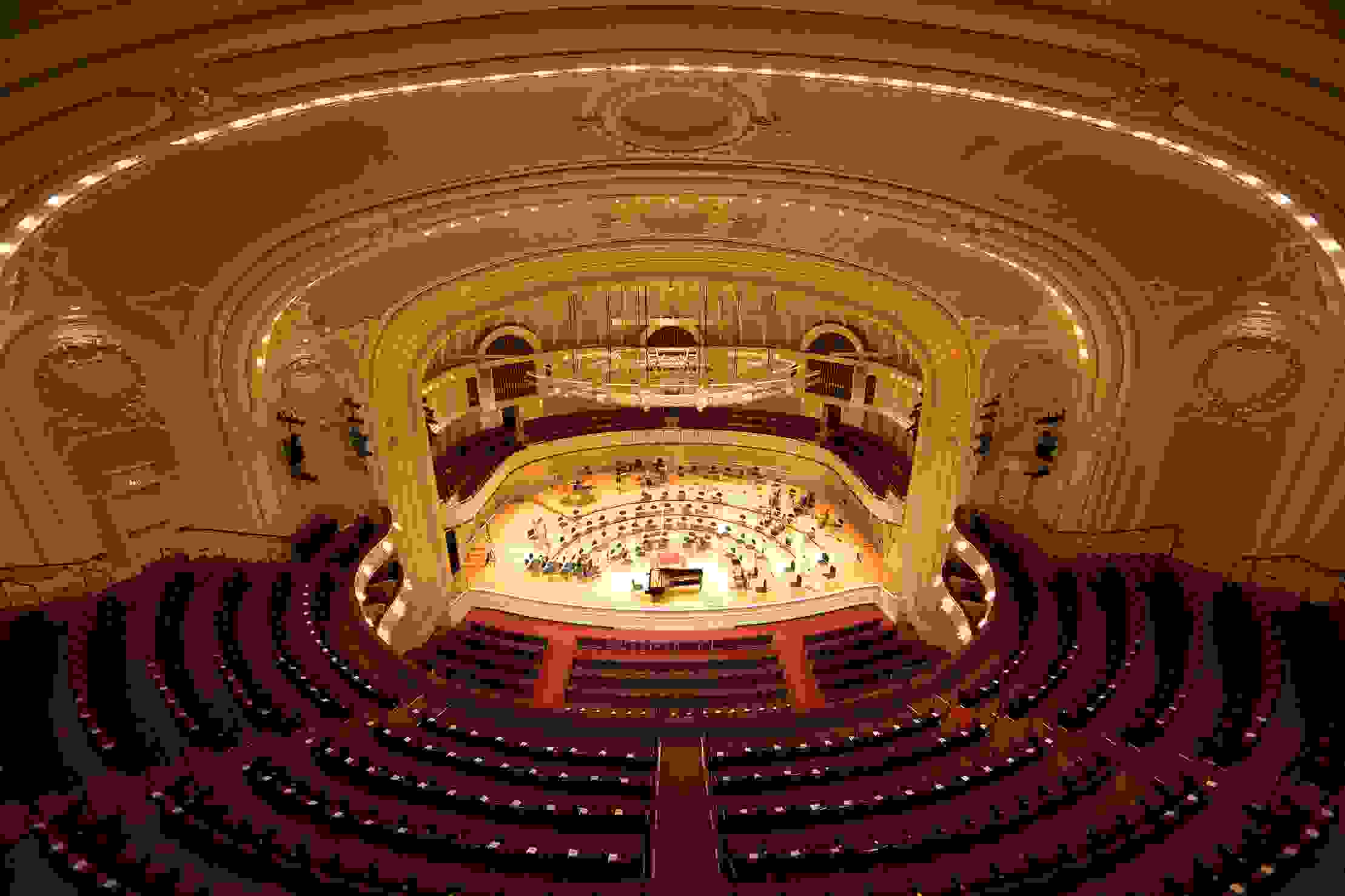
Orchestra Hall at Symphony Center
For nearly the first 14 years of its history, the Chicago Orchestra performed at the Auditorium Theatre (completed in 1889). Orchestra Hall — the long-standing dream of founder and first music director Theodore Thomas — was designed by CSO trustee and Chicago architect Daniel H. Burnham, who had volunteered his services. On the former site of a livery stable owned by Leroy Payne, ground was broken on May 1, 1904, and on December 14, the Hall opened with a dedicatory concert, led by Thomas.
The symmetrical façade of the Hall is of deep pink brick, complemented by white limestone quoins (the wedge-like pieces of stone used as keystones), lintels and other decorative elements characteristic of the Georgian style. Above the second floor of the façade are inscribed in a limestone band the names of five prominent composers (Bach, Mozart, Beethoven, Schubert and Wagner), a nod to the design of the Art Institute of Chicago across the street. The cornice is classical in design and is surmounted by a limestone balustrade that hides the ninth floor (added in 1907), which was, until 1995, the home of the Cliff Dwellers and currently houses the Richard and Helen Thomas Club at Symphony Center.
The high second floor contains the ballroom used for receptions, lectures and chamber music concerts. This room is expressed on the exterior by a row of three two-story windows surmounted by Georgian style fanlights. On either side of this row of windows, a smaller window capped by a classical pediment completes the symmetrical arrangement of the second-floor façade.
The first-floor entrance leads to the vestibule and main lobby, which leads into the auditorium, designed in Beaux Arts style. The original pipe organ, created by Lyon & Healy (the largest instrument the Chicago-based company ever built), was installed early in 1905 and later rebuilt by Frank J. Sauter and Sons in 1946.
In 1950, Daniel Burnham, Jr. was selected as the architect in charge of a $75,000 redecorating, which consisted of painting the Hall’s walls soft gray, the proscenium white and the back wall of the stage Wedgwood blue. The foyer walls were painted muted green and the ceiling terra cotta, and gray carpeting was added on both the main floor and box level.
Harry Weese and Associates were contracted for the first significant renovation that began in 1966, at a cost of nearly $3 million. The project included the installation of new heating and air conditioning along with modern elevators, increase in lobby space on three floors, expansion of musicians’ lounges and dressing rooms and replacement of the plaster ceiling with acoustically designed aluminum panels. The auditorium and lobby décor was brightened with a new color scheme of gray walls with ivory trim, and the seats were reupholstered with deep red mohair. During the summer of 1967, plans to restore the original organ were dismissed when it was discovered that damage had occurred during the previous years’ renovation. An Allen electronic organ was pressed into service as a temporary solution.
During the summer of 1981, M.P. Möller, Inc. installed a new pipe organ, which contained more than 3,000 pipes (45 independent stops and 74 ranks, controlled through 71 registers and 25 couplers). The organ installation was the catalyst for an extensive renovation and remodeling of Orchestra Hall by Skidmore, Owings & Merrill, costing more than $3 million. The project included enlarging the stage and rearranging main floor seating; new lighting set into the stage shell; remodeling Orchestra members’ lounge facilities; complete repainting of the Hall’s interior, following the original design concepts of Daniel Burnham; and other electrical and mechanical adjustments.
In June 1993, the Board of Trustees approved a plan to significantly renovate and expand Orchestra Hall. The $110 million project — led by architects Skidmore, Owings & Merrill and acousticians Kirkegaard Associates — resulted in the completion of Symphony Center, a new music complex, featuring Buntrock Hall, a multipurpose rehearsal and performance space; a six-story rotunda with sky-lit atrium; new administrative offices in the former Chapin & Gore Building; and a beautifully restored and acoustically renovated Orchestra Hall. Work began during the summer of 1995 and Symphony Center officially opened on October 4, 1997, with a gala concert.
At the beginning of the Symphony Center project, the Moeller organ was removed and delivered to the workshops of Casavant Frères in Quebec, Canada, where it was overhauled and expanded. The new instrument (Casavant Frères Opus 3765, consisting of 44 stops, 59 ranks, 14 couplers and 3,414 pipes) was installed during the summer of 1998 and dedicated on February 18, 1999, marking the conclusion of the Symphony Center project.
On March 21, 1978, Orchestra Hall was added to the National Register of Historic Places and on April 19, 1994, it became a National Historic Landmark.
Daniel Burnham's near-final elevation (May 18, 1904) for the façade of Orchestra Hall included the names of five composers: Bach, Mozart, Beethoven, Wagner and Brahms. However, it was decided that Brahms was too contemporary (he had only died in 1897), and he was replaced with Schubert. To maintain chronological order, the names were rearranged: Bach, Mozart, Beethoven, Schubert and Wagner.**